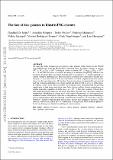| dc.contributor.author | Joshi, Gandhali D | |
| dc.contributor.author | Pillepich, Annalisa | |
| dc.contributor.author | Nelson, Dylan | |
| dc.contributor.author | Marinacci, Federico | |
| dc.contributor.author | Springel, Volker | |
| dc.contributor.author | Rodriguez-Gomez, Vicente | |
| dc.contributor.author | Vogelsberger, Mark | |
| dc.contributor.author | Hernquist, Lars | |
| dc.date.accessioned | 2021-10-27T20:23:15Z | |
| dc.date.available | 2021-10-27T20:23:15Z | |
| dc.date.issued | 2020 | |
| dc.identifier.uri | https://hdl.handle.net/1721.1/135390 | |
| dc.description.abstract | © 2020 The Author(s) Published by Oxford University Press on behalf of the Royal Astronomical Society. We study the stellar morphological evolution of disc galaxies within clusters in the TNG50 and TNG100 runs from the IllustrisTNG simulation suite. We select satellites of masses 109.7 ≤ M∗, z = 0/M· ≤ 1011.6 residing in clusters of masses 1014 ≲ M200c, z = 0/M· ≤ 1014.6 at z = 0 and that were discs at accretion according to a kinematic morphology indicator (the circularity fraction). These are traced from the time of accretion to z = 0 and compared to a control sample of central galaxies mass-matched at accretion. Most cluster discs become non-discy by z = 0, in stark contrast with the control discs, of which a significant fraction remains discy over the same timescales. Cluster discs become non-discy accompanied by gas removal and star formation quenching, loss of dark matter, and little growth or a loss of stellar mass. In contrast, control discs transform while also losing gas mass and quenching, but growing significantly in dark matter and stellar mass. Most cluster satellites change morphologies on similar timescales regardless of stellar mass, in ∼0.5-4 Gyr after accretion. Cluster discs that experienced more numerous and closer pericentric passages show the largest change in morphology. Morphological change in all cases requires the presence of a gravitational perturbation to drive stellar orbits to non-discy configurations, along with gas removal/heating to prevent replenishment of the disc through continued star formation. For cluster discs, the perturbation is impulsive tidal shocking at pericentres and not tidal stripping of outer disc stellar material, whereas for control discs, a combination of mergers and feedback from active galactic nuclei appears to be the key driving force behind morphological transformations. | |
| dc.language.iso | en | |
| dc.publisher | Oxford University Press (OUP) | |
| dc.relation.isversionof | 10.1093/mnras/staa1668 | |
| dc.rights | Creative Commons Attribution-Noncommercial-Share Alike | |
| dc.rights.uri | http://creativecommons.org/licenses/by-nc-sa/4.0/ | |
| dc.source | arXiv | |
| dc.title | The fate of disc galaxies in IllustrisTNG clusters | |
| dc.type | Article | |
| dc.contributor.department | Massachusetts Institute of Technology. Department of Physics | |
| dc.relation.journal | Monthly Notices of the Royal Astronomical Society | |
| dc.eprint.version | Author's final manuscript | |
| dc.type.uri | http://purl.org/eprint/type/JournalArticle | |
| eprint.status | http://purl.org/eprint/status/PeerReviewed | |
| dc.date.updated | 2020-11-17T18:53:13Z | |
| dspace.orderedauthors | Joshi, GD; Pillepich, A; Nelson, D; Marinacci, F; Springel, V; Rodriguez-Gomez, V; Vogelsberger, M; Hernquist, L | |
| dspace.date.submission | 2020-11-17T18:53:19Z | |
| mit.journal.volume | 496 | |
| mit.journal.issue | 3 | |
| mit.license | OPEN_ACCESS_POLICY | |
| mit.metadata.status | Authority Work and Publication Information Needed | |
